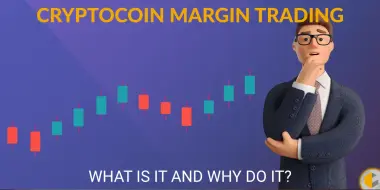
Cryptocoin investment is extremely risky. I want to be absolutely clear: I can not, and will not, provide you with investment or financial advice. You can read more about this in our Terms of Use found at the bottom of every page.
Having said that, the following is a summary of how I approach cryptocoin investment. The majority of this information has been sourced from Reddit. It aligns closely with my own investment approach. I have modified it to reflect my personal preference in parts.
Before Starting with Cryptocoin Investment
- Set your budget - Consider the worst case scenario and think of cryptocoin investment as gambling. Only gamble with the amount of money that you are prepared to lose.
- Set your strategy - Evaluate your time, experience and risk appetite to decide which type of cryptocoin investment you would like to do (day trader, long term holder or somewhere in-between).
- Sit, watch and understand - Just watch the market and the community for a couple of weeks. Be active on any forums or groups which discuss cryptocoin investment or strategies.
- Stalk your target - Learn everything you can about the cryptocoin you want to invest in. You should be able to explain in your own words what the project is and why there is growth potential.
- Steady hands - Don’t buy something because everybody else is. At the same time, don’t sell something because everybody else is either. Understand your entry and exit points for each position you take.
Investment targets
Set your target early. Ideally, relate this back to a standard investment base. For example, given the significant risk, you may want to target twice the current high-interest-savings-account rate. Or perhaps you might want to double an index on the stock market over the same time period. You may end up with a target of 5% to 10% with this method.
A lot of young investors who are in crypto have unrealistic expectations about returns and risk. A lot of them have never invested in any other type of financial asset and many seem to consider a 5-10% ROI in a month to be ‘unexciting’. It’s important to temper your hype and learn why we have had this exponential growth in the last year. Also, to realise how unlikely it will be to see 10x returns in the next year. What we saw recently was Greater Fool Theory in action. Those unexciting returns of 5-10% a month are much more of the norm and much more healthy for an alternative investment class.
You can think about setting a target in terms of the market ROI over a relevant holding period and then add or decrease based on your own risk profile.
Example: Calculating a 2 year ROI target
Lets say you want to hold for 2 years now, how could you set a realistic target to strive for? You could look at a historical 2 year return as a base, preferably during a period similar to what we’re facing now. Now that we had a major correction, I think we can look at the two year period starting in 2015 after we had the 2014 crash. To calculate a 2 year Compound Annual Growth Rate (CAGR) in 2014, 2015 and 2016:
| 2014-2016 | Total Crypto Market Cap |
|---|---|
| Jan 1, 2014 | $10.5 billion |
| Jan 1, 2016 | $7.1 billion |
| 2015-2017 | Total Crypto Market Cap |
|---|---|
| Jan 1, 2015 | $5.5 billion |
| Jan 1, 2017 | $18 billion |
| 2016-2018 | Total Crypto Market Cap |
|---|---|
| Jan 1, 2016 | $7.1 billion |
| Jan 1, 2018 | $33.9 billion |
{#class .table-hover .table-bordered}
CAGR for:
- 2014-2016:[(7.1/10.5)^1/2^]-1 = -1.8%
- 2015-2017:[(18/5.5)^1/2^]-1= 81%
- 2016-2018:[(33.9/7.1)^1/2^]-1 = 118.5%
Taking the median, this annual return rate of 81% comes out to about 4.9% compounded monthly. This may not sound exciting to the lambo-moon crowd, but it will keep your goals in cryptocoin investment grounded. You could aim for a higher return (say 2x of that 81% rate) if you choose to take on more risky propositions. I can’t tell you what return target you should set for yourself. Just make sure it’s not dependent on you needing to achieve continual-near-vertical-parabolic-price-action-in-small-cap-shillcoins because that isn’t sustainable.
Once you have a target, you can construct your risk profile (low risk vs. high risk category coins) in your portfolio based on your target.
Risk Management
All cryptocoin investment is extremely risky, however it still helps to break the level of risk down into these three categories:
- Core holdings - This is the exchange-pairing cryptos and those that are well established. These are almost sure to be around in 5 years and will recover after any bear market. The BTCMarkets’ pairs (Bitcoin, Litecoin and Ethereum) or the top 5 to 10 cryptocoins on coinmarketcap.com could also be included in this class of risk.
- Medium Risk Speculative - These would be cryptocoins which generally have a working product and niche, but are higher risk than Core. Things like Ripple, Cardano, IOTA and NEO. They have a relatively established history but there is still uncertainty over long term viability. This could be a coin/token that has sat in coinmarketcaps top 100 for a while.
- High Risk Speculative - This is anything created within the last few months, ICOs, low caps, shill coins, etc. Most cryptocoins are in this category.
How much risk should you take on? That depends on your own life situation. It also should be proportional to how much expertise you have in both financial analysis and technology.
The general starting point I like to begin with is:
- ⅓ to ⅔ in Low Risk Core. Starting with the majority of your funds in a less risky coin. No less than half in here initially, going down to ⅓ as you gain confidence and experience.
- Always try to keep at least a ⅓ in safer core positions.
- Don’t go all in on speculative picks. I have seen many worthwhile, strong and well implemented cryptocoins disappear overnight for a variety of reasons. Even if you do full due diligence and the project is fantastic, there are many factors well beyond your control which can make these smaller coins crash and burn.
Additional Risk Management
Some more core principles on risk management to consider:
- Diversify across sectors and re-balance your allocations periodically.
- Consider using dollar cost averaging to enter a position. This generally means investing X amount over several periods instead of at once. You can also use downward biased dollar cost averaging to mitigate against downward risk. For example, instead of investing \$1000 all at once in a position at market price, you buy \$500 at the market price today then set several limit orders at slightly lower intervals (for example \$250 at 5% lower than market price, \$250 at 10% lower than market price). This way your average cost of acquisition will be lower if the crypto happens to decline over the short term.
- Don’t have more than 5-10% of your net worth in crypto.
- Have the majority of your holdings in things you feel good holding for at least 2 years. Don’t use the majority of your investment for day trading or short term investing.
- You haven’t actually made any money until you’ve taken some profits. Remember to take some profits when everyone else is at peak FOMO-ing mode.
- Have some fiat in reserve at a large and secure exchange and be ready to add to your winning positions on a pullback. This should be part of your entry strategy.
- Consider what level of loss you are willing to accept in a position with a high risk factor and use stop-limit orders to hedge against sudden crashes. Set you stop price at about 5-10% above your lowest limit. Stop-limit orders aren’t perfect but they’re better than having no hedging strategy for a risky microcap in case of some meltdown. Only you can determine what bags you are unwilling to hold.
Portfolio Allocation
Along with thinking about your portfolio in terms of risk categories described above, I really find it helpful to think about the segments you are in. OnChainFX has some segment categorization but I generally like to bring it down to:
- Core holdings - BTC, Ethereum, LTC, etc
- Platform segment - Ethereum, NEO, Ark, etc
- Privacy segment - Monero, Zcash, PivX, etc
- Government segment - Thekey, Zebi, etc
- Finance/Bank settlement segment - Ripple, Stellar, etc
- Enterprise Blockchain solutions segment - VeChain, Walton, Factom, etc
- Promising Tech segment - NANO/Raiblock, Cardano, etc
Think about your “Circle of Competence”: your body of knowledge that allows you to evaluate an investment. Your ability to properly judge risk and potential is going to largely be correlated to your understanding of the subject matter. If you don’t know anything about how supply chains functions, how can you competently judge whether VeChain or WaltonChain will achieve adoption? If you don’t understand anything about the tech when you read the Cardano paper, are you really able to determine how likely it is to be adopted?
Consider the historic correlations between your holdings. Generally when Bitcoin pumps, altcoins dump but at what rate depends on the coin. When Bitcoin goes sideways we tend to see pumping in altcoins. When Bitcoin goes down, everything goes down.
You should diversify but you really shouldn’t be in much more than a dozen cryptocoins. You simply don’t have enough competency to accurately access the risk across every segment and for every type of crypto you come across. If you have over 20 different cryptos in your portfolio you should probably think about consolidating to a few sectors you understand well.
Crypto Picking Methodology (Due Diligence)
Do you struggle on how to fundamentally analyse cryptocoins? Here is a 3-step methodology to follow to perform your due diligence for cryptocoin investment:
Step 1: Filtering and Research
There is so much out there that you can get overwhelmed. The best way to start is to think back to your own portfolio allocation strategy and what you would like to get more off. For example, in my view, enterprise-focused blockchain solutions will be important in the next few years. So I look to create a list of various cryptocoins that are in that segment.
Upfolio has brief descriptions of the top 100 cryptos and is filterable by categories. For example you can click the “Enterprise” category and you have a neat list of VEN, FCT, WTC…etc.
Read the source material
Once you have a list of potential cryptocoin investment candidates, it’s time to read about them:
- Critically evaluate the website. If it’s a cocktail of nonsensical buzzwords, or unprofessional and poorly made, stay away. Always look for a roadmap and compare to what has actually been delivered so far. Always check the team - try to find them on LinkedIn and learn about their skills and experiences.
- Read the whitepaper. You should fully understand how this crypto functions and how its trying to create value. If there is no use case, or if the use case does not require nor benefit from a blockchain: move on. The project is just trying to raise money in a hot market.
- Check the blockchain explorer. How is the token distribution across accounts? Are the big accounts selling? Try to figure out who the whales are (not always easy!) and what the foundation/founder account is based on the initial allocation.
- Look at the Github repos. Does it look empty or is there plenty of activity? Are there any reasons for the github page to be empty (privacy, IP concerns, country restrictions)?
- Search Social Media. Browse the subreddit and look at a few Medium or Steem blogs about the coin. How “shilly” is the community and how much engagement is there between developer and community? I would also go through the BitcoinTalk thread and Twitter mentions. Judge both the length and quality of the discussion.
- Consider how the coin is being marketed. Are there excessive advertisements targeting less wise investors (facebook ads are a perfect example)? Are people being paid to promote the cryptocoin on their social media front?
Red flags
You can actually filter out a lot of scams and bad investments by simply keeping your eye out on the following red flags:
- allocations that give way too much to the founder,
- guaranteed promises of returns (Bitcooonnneeeect!),
- vague whitepapers filled with buzzwords,
- vague timelines and no clear use case,
- Github with no useful code and sparse activity, and
- a team that is difficult to find information on.
Advertisement Motivation
It is rare to find a person who spends so much time and energy reviewing potential cryptocoin investment options. Also, who has the time to present their findings? It is even more rarer that a person who is genuinely successful in cryptocoin investment strategies wants to share their recipe for success. Many of the big name ‘reviewers’ are receiving a lot of money to promote the cryptocoin in question, regardless of its actual quality. They are also able to benefit by buying in early, giving a small group of insiders the time to buy in, before promoting it to the public. Not only does the reviewer get paid to do this, but they are able to flip the coin for an inflated price as the public swarms in to buy, Rene Rivkin style.
There are lists available on Reddit (example showing the Youtubers) who the community suspect of promoting cryptocoins for payment. Always research where your source of information is coming from.
Some of the social media people suggested by the community (and myself) include:
- Crypto Investor - A generally realistic/pessimistic analysis on the price action from a more serious equity analyst from SeekingAlpha, something desperately needed in crypto.
- CoinMastery - Decent daily commentary and very beginner friendly. It mostly focuses on analyzing sentiment and Cryptocoin Investment.
- IvanOnTech - A programmer’s perspective on various cryptocoins.
- BlockchainBoyz - A group of Australian based blockchain enthusiast including: ByteSizeCapital, RnCrypt, GoodGuyMat, NoamLevenson and BlockchainBrad.
Step 2: Passing a potential pick through a checklist
Once you feel fairly confident that a pick is worth analysing further, run them through a standardised checklist of questions.
This is one I use for myself and on which I base this website’s reports on. Feel free to add other questions yourself:
Cryptocoin Investment Analysis Checklist
- What is the technical development team like? What is their track record? How are they funded, organized?
- How big is the market they’re targeting? Will they be blocked out? Could they survive on a small fraction of that market?
- Who is their competition (both blockchain based and current industries) and how does it differentiate itself?
- What is their roadmap and how well have they kept to it?
- Does any product currently exist? Do they have paying customers or signed contracts in place?
- How does the token/coin actually derive value for the holder? Is there a staking mechanism or is it transactional?
- Is there any new tech and is it informational or governance based?
- Can it be easily copied?
- What are the weaknesses or problems with this crypto?
Benefits of Blockchain
- Transparency and trust. As blockchain are shared, everyone can see what transactions occur. Useful for something like an online casino.
- Immutability. It is extremely difficult to change a transaction once its been put onto a blockchain.
- Distributed availability. The system is spread on thousands of nodes on a P2P network so it’s difficult to take the system down.
- Security. Cryptographically secured transactions provide integrity.
- Simplification and consolidation. A blockchain can serve as a shared ledger in industries where multiple entities previously kept their own data sources.
- Quicker Settlement. In the financial industry, when we’re dealing with post-trade settlement, a blockchain can drastically increase the speed of verification.
- Cost. In some cases, avoiding a third party verification would drastically reduce costs.
Step 3: Create a valuation model
You don’t need to get into full modeling or have a financial background. Just start with a simple model that tries to derive a valuation through relative terms. This will put you above most cryptocoin investment groups. Some simple valuation methods that anyone can do:
Probablistic Scenario Valuation
This is all about thinking of scenarios and probability, a helpful exercise in itself. For example: Bill Miller, a prominent value investor, wrote a probabilistic valuation case for Bitcoin in 2015. He looked at two possible scenarios for probabalistic valuation:
- becoming a store-of-value equal to gold (a \$6.4 trillion value), with a .25% probability of occurring
- replacing payment processors like VISA, MasterCard, etc. (a \$350 million dollar value) with a 2.5% probability
Combining those scenarios would give you the total expected market cap:
(0.25% x 6.4 trillion) + (2.5% x 350 million). Divide this by the outstanding supply and you have your valuation.
Metcalfe’s Law
Metcalfe’s Law which states that the value of a network is proportional to the square of the number of connected users of the system (n^2).^ So you can compare various currencies based on their market cap and square of active users or traffic. We can alter this to crypto by thinking about it in terms of both users and transactions:
For example, compare the Coinbase pairs:
| Metric | Bitoin | Ethereum | Litecoin |
|---|---|---|---|
| Market Cap | $152 Billion | $93 Billion | $7.3 Billion |
| Daily Transactions (last 24hrs) | 249,851 | 1,051,427 | 70,397 |
| Active Addresses (Peak 1Yr) | 1,132,000 | 1,035,000 | 514,000 |
| Metcalfe Ratio (Transactions Based) | 2.43 | 0.08 | 1.47 |
| Metcalfe Ratio (Address Based) | 0.12 | 0.09 | 0.03 |
Generally the higher the ratio, the higher the valuation given for each address/transaction.
Market Cap to Industry comparisons
Another easy one is to look at the total market for the industry that the coin is targeting, and compare it to the market cap of the coin. Think of the market cap not only as circulating supply, such as that shown on CMC, but also including total supply. For example, the total supply for Dentacoin is 1,841,395,638,392. When multiplied by its price in early January, we get a market cap that is actually higher than the entire industry it aims to disrupt: Dentistry.
More complex valuation models
If you would like to get into more fleshed out models with Excel, I highly recommend Chris Burniske’s blog about using Quantity Theory of Money to build an equivalent of a DCF analysis for crypto.
Here is an Excel file example of OMG done by Nodar Janashia using Chris’ model.
You should create multiple scenarios with multiple assumptions, both positive and negative. Have a base scenario and then moderately optimistic/pessimistic and highly optimistic/pessimistic scenario.
Personally, I like to see at least a 50% upward potential before investing from my moderately pessimistic scenario, but set your own safety margin.
The truly beneficial thing about modelling isn’t even the price or valuation comparisons it spits out, but that it forces you to think about why the coin has value and what your own assumptions about the future are. For example, the discount rate you apply to the net present utility formula drastically affects the valuation and reflects your own assumptions of how risky the crypto is. What exactly would be a reasonable discount rate? Consider the digital economy you are assuming for the coin. What levers affect its size and adoption and how likely is it that your assumptions will come true? You’ll be a drastically more intelligent investor if you think about the fundamental variables that give your coin the market cap you think it should hold.
Summing it up
This post is my attempt at documenting how I approach investing into cryptos. How I construct a portfolio allocation, taking into consideration risk and return targets. What my systematic crypto picking method is. I won’t tell you what to buy, you should always decide that for yourself and do your own research. But as long as you follow a rational and thorough methodology, you will feel pretty good about your cryptocoin investment even when times get tough.
While there is money being made simply flipping coins, I look for the coins I would be happy to hold onto for a year or two. This forces me to conduct proper research into the project team and the actual product before contributing to it.
Editor-in Chief
Related Posts






Subscribe to our newsletter!
Information


